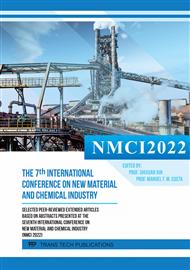[1]
J. H. Chen, Y. X. Wang, J. Liu, X. L. Xu. Int J Biol Macromol. 148 (2020) 1169-1181.
Google Scholar
[2]
M. Lei, F. C. Jiang, J Cai, S. Hu, R. Zhou, G. Liu, Y. H. Wang, H. B. Wang, J. R. He, X.G. Xiong. Int J Biol Macromol. 111 (2018) 755-761.
Google Scholar
[3]
Z. Hadisi, J. Nourmohammadi, J. Mohammadi. Ceram Int. 41 (2015) 10745-10754.
Google Scholar
[4]
Y. B. Xiang, J. H. Han, G. Zhang, F. R. Zhan, D. Q. Cai, Z. Y. Wu. ACS Sustain Chem Eng. 6 (2018) 3649-3658.
Google Scholar
[5]
C. Y. Xi, L. G. Zhu, Y. Zhuang, S. F. Wang, G. X. Sun, Y. Q. Liu, D. Q. Wang. Clin Appl Thromb-hem. 24 (2018) 279.
Google Scholar
[6]
G. M. Glenn, A. P. Klamczynski, D. F. Woods, B. S. Chiou, W, J, Orts, S. H. Imam. J Agr Food Chem. 58 (2010) 4180-4184.
DOI: 10.1021/jf9037826
Google Scholar
[7]
C Belingheri, A Ferrillo, E Vittadini. Lwt-food Sci Technol. 60 (2015) 593-597.
DOI: 10.1016/j.lwt.2014.09.047
Google Scholar
[8]
C Belingheri, E Curti, A Ferrillo, E Vittadini. Food Funct. 3 (2012) 255-261.
DOI: 10.1039/c1fo10184f
Google Scholar
[9]
Y. G. Xing, Q. L. Xu, Y Ma, Z. M. Che, Y. M. Cai, L Jiang. Food Funct. 5 (2014) 972-983.
Google Scholar
[10]
Y. F. Wang, H. Ye, C. H. Zhou, F. X. Lv, X. M. Bie, Z. X. Lu. Eur Food Res Technol. 234 (2012) 157-163.
Google Scholar
[11]
J. Z. Zhu, L. Zhong, W. X. Chen, Y. Z. Song, Z. M. Qian, X. Y. Cao, Q. Huang, B. Zhang, H. M. Cheng, W. J. Chen. Food Hydrocolloid. 95 (2019) 562-570.
Google Scholar
[12]
J. C. Spada, L. D. F. Marczak, I. C. Tessaro, C. Pelayo, Z. Noreña. Int J Food Sci Tech. 47 (2012) 186-194.
Google Scholar
[13]
G. Chen, B. Zhang. J Cereal Sci. 56 (2012) 316-320.
Google Scholar
[14]
Y. Benaventgil, C. M. Rosell. Carbohyd Polym. 157 (2017) 533-540.
Google Scholar
[15]
Y. S. Chen, S. R. Huang, Z. F. Tang, X. W. Chen, Z. F. Zhang. Carbohyd Polym. 85 (2011) 272-275.
Google Scholar
[16]
A. Dura, W. Blaszczak, C. M. Rosell. Carbohyd Polym. 101 (2014) 837-845.
Google Scholar
[17]
M. Majzoobi, S. Hedayati, A. Farahnaky. Food Biosci. 11 (2015) 79-84.
Google Scholar
[18]
B Zhang, D. P. Cui, M. Z. Liu, H. H. Gong, Y. J. Huang, F. Han. Int J Biol Macromol. 50 (2012) 250-256.
Google Scholar
[19]
G. L. Miller. Anal Chem. 31 (1959) 426-428.
Google Scholar
[20]
L. Guo, G. Y. Li, J. S. Liu, Y. F. Meng, Y. F. Tang. Carbohyd Polym. 93 (2013) 374-379.
Google Scholar
[21]
Y. Xie, M. N. Li, H. Q. Chen, B. Zhang. Food Chem. 274 (2019) 351-359.
Google Scholar
[22]
S. Pérez, E. Bertoft. Starch‐Stärke. 62 (2010) 389-420.
Google Scholar
[23]
Y. Jung, B. H. Lee, S. H. Yoo. Plos One. 12 (2017) e0181372.
Google Scholar
[24]
S. Nara, T. Komiya. Starch‐Stärke. 35 (1983) 407-410.
Google Scholar
[25]
W. Q. Wu, A. Q. Jiao, E. B. Xu, Y. Chen, Z. Y. Jin. Food Bioprocess Tech. 13 (2020) 442-451.
Google Scholar
[26]
F. Gao, D. Li, C. Bi, Z. Mao, B. Adhikari. Dry Technol. 31 (2013) 1627-1634.
Google Scholar
[27]
A. Q. Zhao, L. Yu, M. Yang, C. J. Wang, M. M. Wang, X. Bai. Food Hydrocolloid. 83 (2018) 465-472.
Google Scholar
[28]
L. D. Lacerda, D. C. Leite, R. M. D. Soares, N. P. D. Silveira. Starch‐Stärke. 70 (2018) 1800008.
Google Scholar
[29]
J. J. Zhu, W. Z. Sun, Z. Y. Meng, X. X. Zhu, H. Gan, R. L. Gu, Z. N. Wu, G. F. Dou. Int J Biol Macromol. 116 (2018) 707-714.
Google Scholar
[30]
H. L. Wang, J. Lv, S. W. Jiang, B. C. Niu, M. Pang, S. T. Jiang. Starch‐Stärke. 68 (2016) 1254-1263.
Google Scholar
[31]
W. R. Yao, H. Y. Yao. Starch‐Stärke. 54 (2002) 260-263.
Google Scholar
[32]
L. Guo, G. Y. Li, J. S. Liu, Y. F. Meng, Y. F. Tang. Carbohyd Polym. 93 (2013) 374-379.
Google Scholar



